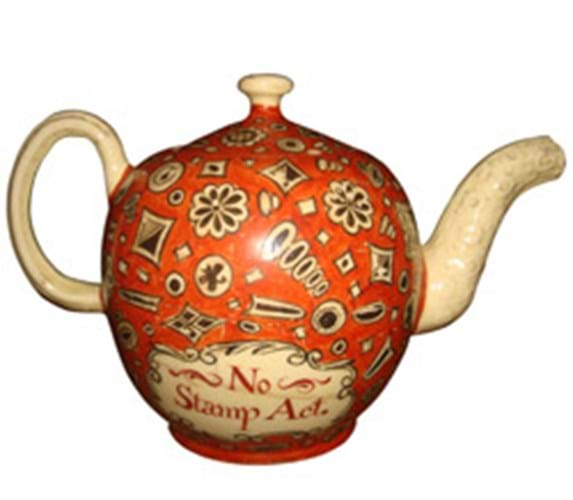
Charles Hanson of Hansons had found the 5in (12cm) high No Stamp Act teapot in a box of bric-a-brac at a home near Sutton Coldfield.
Against a vibrant orange ground punctuated by floral and geometric motifs, it was inscribed in puce Success to Trade in America and to the reverse in similar script No Stamp Act. These phrases are associated with the tax on all printed materials imposed on the colonies in March 1765, a hated levy that set in motion the course of events that led to the American Revolution.
The teapot was probably made shortly after the repeal of the Stamp Act in March 1766 and illustrates how important trade with the American colonies was to British industry.
It is one of a small handful of surviving No Stamp Act teapots that have become icons of American collecting. The other four known are also in creamware but relatively plain in comparison.
One restored example inscribed in black No Stamp Act and America: Liberty Restored was acquired by The National Museum of American History at Northeast Auctions of Portsmouth, New Hampshire in October 2006 for $85,000.
Another with the same inscription in iron red within floral wreaths, also badly damaged, sold to dealer Todd Prickett for $130,000 at Pook & Pook of Downington, Pennsylvania in April 2007.
The other published examples are in the DeWitt Wallace Decorative Arts Museum at Colonial Williamsburg, and in the Peabody Essex Museum.
This latest discovery from Sutton Coldfield is arguably the most extraordinary of the group, not least for its chintz 'fossil' ground decoration that has few comparables. It was also in relatively good condition with only a horizontal hair crack and chips to the extremities.
Charles Hanson - who had shocked his vendor before the sale when suggesting it might be worth up to £2000 (the published estimate was just £400-600) - fielded bids from English dealers before it sold to a bidder from California on the telephone.
The buyers premium was 15 per cent.
By Roland Arkell




